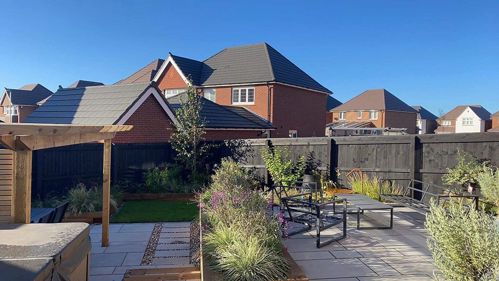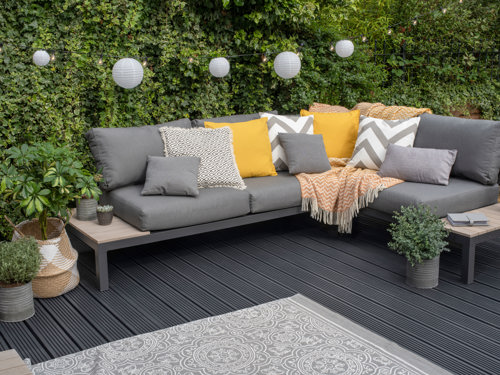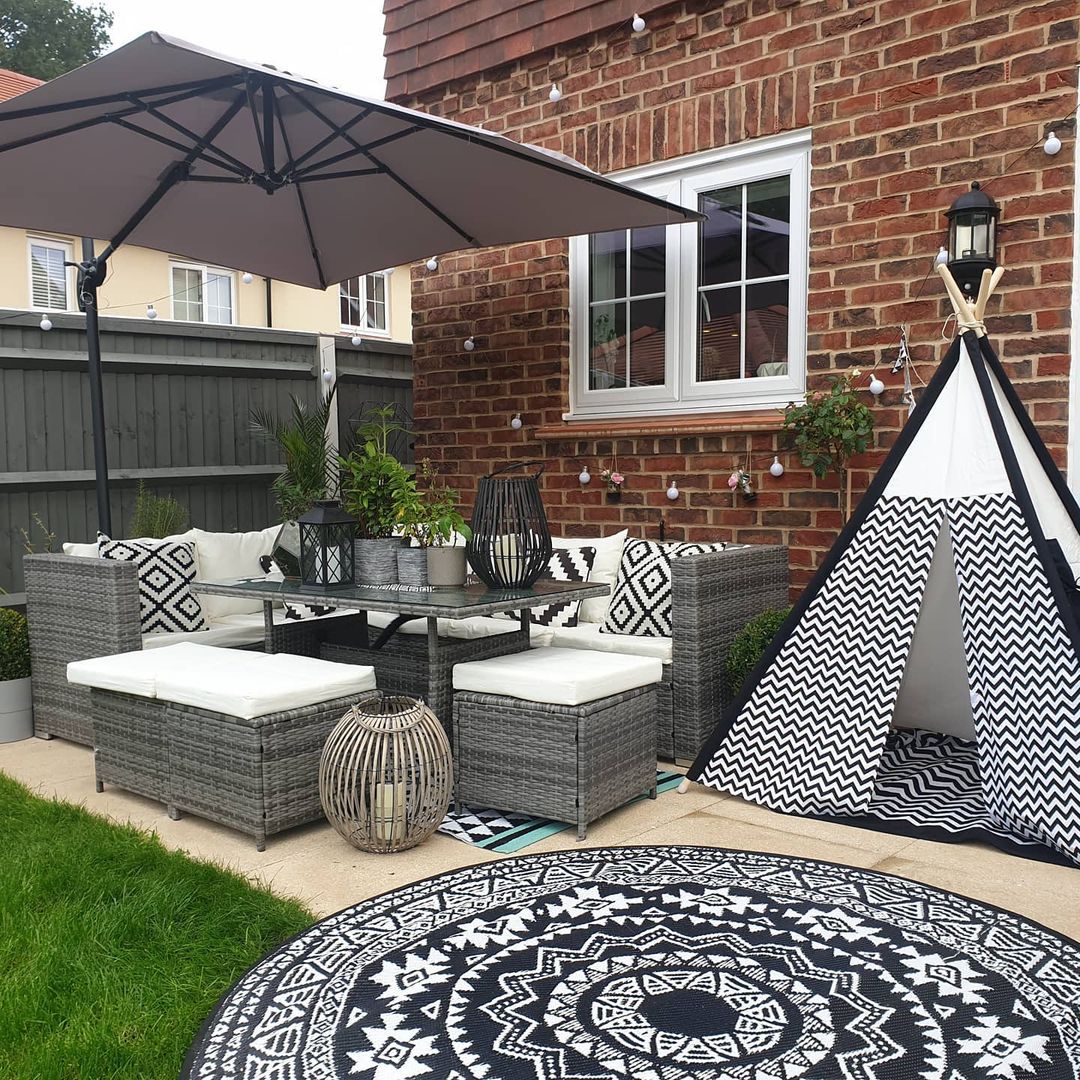Garden zoning is an efficient and effective way to make the most of your outdoor areas. Put simply, it’s about sectioning up your plot to create pockets of space that are dedicated to certain activities.
From kids’ play corners to starlit dining spots, there are so many hubs you can introduce to your home. And, depending on your garden style and size, you can use a variety of sectioning techniques.
However you go about garden zoning, the end result is always the same - a garden that’s more inviting, practical and interesting to look at.
When looking at how to zone a garden, it’s important to envisage how you’ll use the space as well as the finished look you’d like to create.
There are plenty of practical elements to plan for of course (such as sun levels and electricity access). You may also want a factor in the dimensions and design of your home. We’ll explore more of these planning points later in the article. But before we do, let’s look at some of the many methods you can use to create your zones.
1. Clever colour schemes
Credit: Interiors_with_zee
Assigning a colour scheme to a zone unites the space and gives it a clear visual identity. It can also help tie your garden into the decoration and details found in your home.
For a flexible and short-term solution, invest in an outdoor rug in the tone of your choice. Next, echo the palette from the rug in your furniture and decorative details. Our Garden Paint comes in 29 colours and is perfect for upcycling old items and bringing them into a new scheme.
Top Tip: Props are a great way to give purpose to a garden zone and make it easier to identify. Here, a child’s wigwam highlights that this zone is family-friendly rather than an adult-only area.
2. Light it up
Credit: renovation_44
Lighting is a warm and welcoming sectioning device that adds atmosphere to your garden. It also helps to identify evening entertainment spaces. When a zone is dressed in lighting, it draws the eye down your garden and people will also gravitate towards it.
Just like a clever colour scheme, lighting is especially useful in smaller gardens where you need to zone an area without taking any floor space.
Top tip: Choose a lighting style that reflects your home and desired mood. Neon lights provide a modern, social feel whilst hurricane lamps may suit more rustic and romantic moments.
3. Layer your landscape
Credit: make.ahouseyourhome
Adding layers into your garden design allows you to physically separate each zone. It’s also a good device to use if your garden is naturally unlevel.
Add further definition by using a variety of flooring options for each section. And, if you have a wide or large space to break up, use furniture and raised beds to add interest and purpose.
Top tip: When sectioning up a space on the same layer, try using flat-backed, block furniture. The shape of the chairs used in this garden give the illusion of a sectional fence between eating and lounge areas.
4. Raise the roof
Credit: ourhome_upnorth
Come rain or shine, we all seek out shelter when outdoors. But installing an awning, parasol or canopy can offer much more than shade or a spot to escape the rain.
When used in a garden zoning design, overhead cover clearly earmarks an area. It’s especially effective when assigning a zone for respite. Combine your shelter with a corner location to recreate the security of an indoor environment.
Top tip: If you’re looking to dedicate a zone to relaxation, decorate it with natural fibres and neutral colours. Soft throws, jute rugs and a fence treated in Fence Life Plus in Tudor Black Oak will do just the trick!
5. Features with feeling
Credit: Our_little_doer_upper
Features such as hot tubs, fire pits and BBQs automatically add purpose to an area. They’ll also provide a focal point. The mood you set for this zone, and the people that are drawn to it, will depend on all finer details.
In this garden, the hot tub area is given a more intimate, spa-like vibe through an exotic plant selection and dark, dramatic fencing. It feels like a very relaxed, secluded and grown up zone.
Top tip: Using coloured lighting, rather than traditional warm or cool white lights, will add to the ambience.
6. Partition planting
Credit: oneninebridgewater
Plant-filled partitions are arguably the most rewarding zoning solutions. Not only will they look and smell fantastic, but they’ll improve your air quality and invite wildlife in too.
You might want to go for an archway adorned with climbing plants such as ivy or clematis. Solid hedging can provide more privacy. For a more open plan design, try lavender-lined borders, rockeries or areas filled with oriental grasses.
Top tip: For a more delicious division, why not grow an edible screen. Fruit trees such as apple and pear can be trained to grow along a system of horizontal wires and posts. They’ll provide spring blossoms and plenty of healthy snacks!
7. Set the stage
Credit: the_grey_residence_no_4
Decking is a great garden zoning device. It sets a stage for an activity and can create a more usable space. With its even, durable surface, decking lends itself to eating, entertaining and exercise.
Treating your deck in a lighter shade, such as Ultimate Protection Decking Paint in Warm Stone, will help your zone stand out and give a comfortable, interior-like feel.
Top tip: If you’re looking to provide more privacy for your dedicated zone, pair your decking with slatted fencing. Slatted panels provide a barrier without completely screening off the surroundings. They can also provide a little sound protection if the next zone is a little noisy.
8. Table manners
Credit: Keep_things_simple
There’s something about a table that centres a space. And, when you combine it with a parasol for shade and a gravel floor area, it evolves into a dedicated dining zone.
To elevate the feeling of seclusion whilst maintaining a flow through to the garden, frame the area with potted plants, ferns and small trees.
Top Tip: Our Fence Life Plus in Tudor Black Oak is the perfect partner for a monochrome dining set. It will outline your zone area and tie into the furniture without stealing the spotlight.
9. Section with seating
Credit: Ronseal
The style, size and positioning of your seating can really help when garden zoning. A corner sofa, for instance, is a great way to suggest socialising. In comparison, a cocoon or egg chair will encourage people to take time out alone.
The shape of the chairs itself can also influence the space. Rounded, lightweight designs help to create flow from one zone to the next. Straight edges are better for forming barriers.
Top tip: Repurpose old seating using our Garden Paint. Bright colours like Summer Sky or Pink Jasmine work well in a kid-friendly area, whilst White Ash and Elderflower will make a zone feel more mellow.
10. Feature fencing
Credit: shelley_cottage
A fence is functional but it can also be a great canvas for creative garden zoning too. Adding embellishments to your fencing can help to bring focus to a zone in your garden. It will also add to whatever vibe you’re looking to create.
In this particular garden design, the fence has been layered with trellis panels and climbing plants to bring texture to a cosy corner. A backdrop of Fence Life Plus in Warm Stone, potted plants and an inviting seating area also helps to set the scene. Top tip: When exploring climbers as part of a garden zoning design, do research to find the right fit for you. You may want to opt for a low maintenance option or one that’s evergreen.
How to zone a small gardenZoning a small garden involves many of the same practices and decisions as a larger plot. However, a little more planning at the outset of your project, could help you make the most of your design.
If you approach garden zoning in the right way, it can even make a space feel bigger.
Here’s a list of suggested steps to get you started
- As with any garden zoning project, start by planning out the pastimes you want to enjoy, and the people you want to enjoy them with. This could be eating with friends, playing with the kids or even a spot of yoga alone.
- Next, assign a location for each zone. When deciding what hub goes where, try to think about the following:
The conditions - monitor the levels of sunshine/shade/wind each zone gets and think about what activity works best with that.
Lines of sight - outline which zones you want to feel hidden and secluded (e.g., a fire pit or reading nook) or more visible (a play area for children). Use low layers to help your garden look deeper and larger.
Proximity to the house - keep activities like eating or cooking closer to your house as they’re likely to involve frequent trips to the kitchen for supplies.
Noise levels - plan your zones to minimise disruption or conflicting moods. For instance, you may not want to introduce a dance floor under the kids’ bedroom window or put the play area next to your yoga retreat!
Fittings and furniture - to make the most of your space, try looking for items that can double up in their purpose.
Multipurpose moments - when space is squeezed, design zones with multiple functions. It could be that they have one purpose during the daytime and another at night.
Sources and supplies - explore whether you need electric outlets or a water supply for a specific zone and ensure you can access this.
Sectioning devices - as we’ve explored above, there are lots of different ways to zone a garden. From fixed fencing to more open lighting schemes, your decision should factor in how flexible you want your space to be and a design scheme that suits the rest of your property. In smaller spaces, using colours or layers to visibly define an area can be more effective than stone walls or large landscaped installations.
Finally, get your transformation underway!
Ready to start your very own garden zoning design? Or are you eager to research other tips and tricks for garden renovations? If so, take a look at our guide on how to make the most of your garden.
